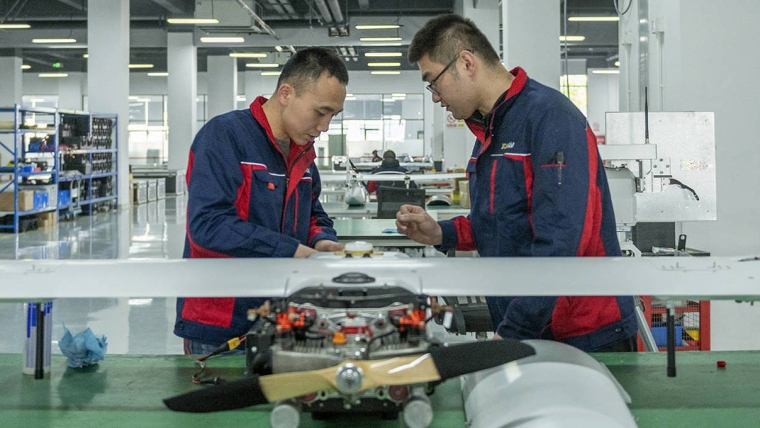
Chinese manufacturing has come a long way – and by some measures, it is stronger than ever. Whereas foreign-invested enterprises were the driving force behind China’s manufacturing exports 20 years ago, most of these firms are now leaving China, having lost their market share to domestic competitors. And these dominant Chinese companies are not limited to the low-value-added production of the past. They are global leaders in many high-tech industries, such as semiconductors and electric vehicles, where they hold an absolute price advantage.
Today’s China is reminiscent of Japan and South Korea in their heyday. In the 1970s, Japan was producing high-tech products, including home appliances and automobiles, that outperformed American alternatives. And in the 1990s, South Korea emerged as a powerhouse in the electronics and automobile industries. The difference is that the per capita GDP of Japan in the 1970s and South Korea in the 1990s was approaching half that of the United States, but China’s per capita GDP, in nominal terms, amounts to less than 16% of America’s today (US$13,300, compared to US$85,800).
The obvious question is how a country with such low per capita GDP has managed to reach the technological frontier in so many sectors. Another, perhaps more interesting question is how China manages to keep the prices of the cutting-edge technologies it produces so low. In both cases, an important part of the answer is China’s massive scale.
If a country with a huge population can deliver high-quality education to its people, it will eventually accumulate disproportionate human capital. Such a country will learn more readily from advanced economies and develop its own innovative capacity earlier in its development. Though China had little trade with the West during the Mao era, it had a large contingent of elites who had studied at Western universities prior to the establishment of the People’s Republic. This group played an extremely important role in advancing China’s scientific research and technology sector, helping to industrialize the economy with technical assistance from the Soviet Union. More importantly, China successfully established a modern basic education system in the 1950s, making it free for all Chinese children despite the country’s high levels of extreme poverty, and also restructured its higher-education system.
Most of China’s prestigious universities at the time had been established by Western religious institutions and missionary groups during the late Qing Dynasty (which ended in 1911) and the early Republic of China period (1911-49). But under Mao, China embraced the Soviet model of higher education, which emphasized vocational and technical training, with a special focus on science and engineering. Unlike the Western model, which emphasized liberal education, the Soviet system aimed to produce specialists with practical qualifications.
Over the last 40 years, China has retained this basic model and made it increasingly accessible. Since the government’s 1999 decision to expand university enrollment, the annual number of university graduates has surged from one million in 1999 to 12 million today, roughly half of whom hold degrees in science, technology, engineering, or mathematics. Today, China has nearly five times as many STEM graduates as the US, and seven times as many engineers. This explains why, unlike American consumers, Chinese consumers enjoy effective, affordable, and widely available after-sales and maintenance services on the products they purchase, from electronics to EVs.
China has also seen the value of learning from the West, sending more than six million students to foreign universities over the last 40 years, the majority of whom have returned to China after completing their studies. This has contributed substantially to China’s manufacturing catch-up, especially over the last two decades.
But education was just part of the equation. China’s 1979 decision to allow local firms to establish joint ventures with foreign companies led to technological upgrading in a broad range of sectors. Crucially, as China built up increasingly advanced manufacturing capabilities, it also developed supply chains and supporting infrastructure. Today, China’s manufacturing sector depends on a robust network of suppliers, innovators, manufacturers, and logistics providers.
China’s government has played a vital role in building and nurturing this ecosystem. But, contrary to the prevailing impression in the West, this is not an exclusively – or even primarily – top-down process. China is composed of 31 provinces, around 300 prefecture-level cities, and about 2,800 counties and cities, and at every level, governments compete with one another to promote growth and industrial development. While the central government sets priorities, any policy it introduces to support specific industries functions, in practice, as a horizontal competition policy. This economic strategy – made possible by China’s massive scale – has been essential to the rapid development and continued competitiveness of Chinese manufacturing.
Zhang Jun, Dean of the School of Economics at Fudan University, is Director of the China Center for Economic Studies, a Shanghai-based think tank. Copyright 2025 Project Syndicate, here with permission.
3 Comments
IMO China can be proud of it's advances but I won't be purchasing made in China high tech products e.g heat pump even though they are lower cost until I'm more confident about product durability, and performance and repair guarantees. If the electronics for instance has lower rated components to save a few dollars I'd want to stay well clear of them. There's no practical way of knowing this as a customer our only protection is a guarantee and well established product aftersales testing and repair services.
China is quickly moving from bottom producer to top. It's happened before with the Northern states of the USA being known for shoddy goods during their Civil War and then the same applied to Japanese products in the Fifties and Sixties until first the British motorbike companies dissolved and then British Leyland crumbled. When you are top manufacturer you need patents with solid enforcement and rule of law. China is changing rapidly - they now have companies whose most valuable item is their reputation not their price.
I'm long retired and I expect what you say about say heat pumps is true. But sector by sector it is changing.
I've been trying to learn about Robotics - just trying to work out where it is and where it is going. Modern humanoid robots are still at an early stage of development and success requires programming the software and building the machine. The coding could be done anywhere but testing it needs the machine and that is built of innumerable electric motors, capacitors, special batteries, cables, widgets, etc, etc. Only China has cities with all those small specialist manufacturers in close proximity; for example Hangzhou. It was what Birmingham was famous for seventy years ago until the UK govt decided industries should be distributed around the country. I'm guessing Seoul and Tokyo may still have similar but not as bustling as China. The USA had one that I think is now called the rust belt. Read about Wang Xingxing and Unitree for an example of a Chinese advanced manufacturer that has minimal foreign roots - just young engineers from Chinese universities.
So the result of my reading is the conclusion that China will dominate this growth industry. They may even manufacture overseas but the patents and the brains will be Chinese. And so will the profits. It is a near certainty with only their president Xi capable of sabotaging it.

We welcome your comments below. If you are not already registered, please register to comment.
Remember we welcome robust, respectful and insightful debate. We don't welcome abusive or defamatory comments and will de-register those repeatedly making such comments. Our current comment policy is here.